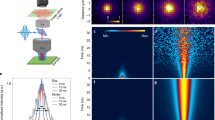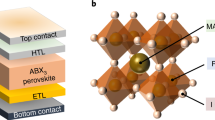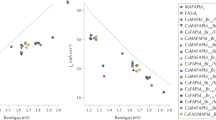Abstract
Perovskite solar cells show excellent power conversion efficiencies, long carrier diffusion lengths and low recombination rates. This encourages a view that intragrain defects are electronically benign with little impact on device performance. In this study we varied the methylammonium (MA)/formamidinium (FA) composition in MA1–xFAxPbI3 (x = 0–1), and compared the structure and density of the intragrain planar defects with device performance, otherwise keeping the device nominally the same. We found that charge carrier lifetime, open-circuit voltage deficit and current density–voltage hysteresis correlate empirically with the density and structure of {111}c planar defects (x = 0.5–1) and {112}t twin boundaries (x = 0–0.1). The best performance parameters were found when essentially no intragrain planar defects were evident (x = 0.2). Similarly, reducing the density of {111}c planar defects through MASCN vapour treatment of FAPbI3 (x ≈ 1) also improved performance. These observations suggest that intragrain defect control can provide an important route for improving perovskite solar cell performance, in addition to well-established parameters such as grain boundaries and interfaces.
This is a preview of subscription content, access via your institution
Access options
Access Nature and 54 other Nature Portfolio journals
Get Nature+, our best-value online-access subscription
$29.99 / 30 days
cancel any time
Subscribe to this journal
Receive 12 digital issues and online access to articles
$119.00 per year
only $9.92 per issue
Buy this article
- Purchase on Springer Link
- Instant access to full article PDF
Prices may be subject to local taxes which are calculated during checkout




Similar content being viewed by others
Data availability
Source data are provided with this paper. All other data generated or analysed during this study are included in the published article and its Supplementary Information files.
References
Ball, J. M. & Petrozza, A. Defects in perovskite-halides and their effects in solar cells. Nat. Energy 1, 16149 (2016).
Yang, W. S. et al. Iodide management in formamidinium-lead-halide–based perovskite layers for efficient solar cells. Science 356, 1376–1379 (2017).
Luo, W. et al. Potential-induced degradation in photovoltaic modules: a critical review. Energy Environ. Sci. 10, 43–68 (2017).
Yoo, S.-H. et al. Identification of critical stacking faults in thin-film CdTe solar cells. Appl. Phys. Lett. 105, 062104 (2014).
Fan, Z. et al. Ferroelectricity of CH3NH3PbI3 perovskite. J. Phys. Chem. Lett. 6, 1155–1161 (2015).
Klein-Kedem, N., Cahen, D. & Hodes, G. Effects of Light and electron beam irradiation on halide perovskites and their solar cells. Acc. Chem. Res. 49, 347–354 (2016).
Rothmann, M. U. et al. Structural and chemical changes to CH3NH3PbI3 induced by electron and gallium ion beams. Adv. Mater. 30, 1800629 (2018).
Wehrenfennig, C., Eperon, G. E., Johnston, M. B., Snaith, H. J. & Herz, L. M. High charge carrier mobilities and lifetimes in organolead trihalide perovskites. Adv. Mater. 26, 1584–1589 (2014).
Yin, W.-J., Shi, T. & Yan, Y. Unique properties of halide perovskites as possible origins of the superior solar cell performance. Adv. Mater. 26, 4653–4658 (2014).
Stranks, S. D. Nonradiative losses in metal halide perovskites. ACS Energy Lett. 2, 1515–1525 (2017).
Chen, B., Rudd, P. N., Yang, S., Yuan, Y. & Huang, J. Imperfections and their passivation in halide perovskite solar cells. Chem. Soc. Rev. 48, 3842–3867 (2019).
McKenna, K. P. Electronic properties of {111} twin boundaries in a mixed-ion lead halide perovskite solar absorber. ACS Energy Lett. 3, 2663–2668 (2018).
Tan, C. S. et al. Heterogeneous supersaturation in mixed perovskites. Adv. Sci. 7, 1903166 (2020).
Röhm, H., Leonhard, T., Hoffmann, M. J. & Colsmann, A. Ferroelectric poling of methylammonium lead iodide thin films. Adv. Funct. Mater. 30, 1908657 (2020).
Rothmann, M. U. et al. Direct observation of intrinsic twin domains in tetragonal CH3NH3PbI3. Nat. Commun. 8, 14547 (2017).
Weber, O. J., Charles, B. & Weller, M. T. Phase behaviour and composition in the formamidinium-methylammonium hybrid lead iodide perovskite solid solution. J. Mater. Chem. A 4, 15375–15382 (2016).
Binek, A., Hanusch, F. C., Docampo, P. & Bein, T. Stabilization of the trigonal high-temperature phase of formamidinium lead iodide. J. Phys. Chem. Lett. 6, 1249–1253 (2015).
Weller, M. T., Weber, O. J., Frost, J. M. & Walsh, A. Cubic perovskite structure of black formamidinium lead iodide, α-HC(NH2)2PbI3, at 298 K. J. Phys. Chem. Lett. 6, 3209–3212 (2015).
Charles, B., Dillon, J., Weber, O. J., Islam, M. S. & Weller, M. T. Understanding the stability of mixed A-cation lead iodide perovskites. J. Mater. Chem. A 5, 22495–22499 (2017).
Pisanu, A. et al. The FA1–xMAxPbI3 system: correlations among stoichiometry control, crystal structure, optical properties, and phase stability. J. Phys. Chem. C. 121, 8746–8751 (2017).
Rothmann, M. U. et al. Atomic-scale microstructure of metal halide perovskite. Science 370, eabb5940 (2020).
Lu, H. et al. Vapor-assisted deposition of highly efficient, stable black-phase FAPbI3 perovskite solar cells. Science 370, eabb8985 (2020).
Pellet, N. et al. Mixed-organic-cation perovskite photovoltaics for enhanced solar-light harvesting. Angew. Chem. Int. Ed. 53, 3151–3157 (2014).
Dai, J. et al. Carrier decay properties of mixed cation formamidinium–methylammonium lead iodide perovskite [HC(NH2)2]1–x[CH3NH3]xPbI3 nanorods. J. Phys. Chem. Lett. 7, 5036–5043 (2016).
Li, W.-G., Rao, H.-S., Chen, B.-X., Wang, X.-D. & Kuang, D.-B. A formamidinium-methylammonium lead iodide perovskite single crystal exhibiting exceptional optoelectronic properties and long-term stability. J. Mater. Chem. A 5, 19431–19438 (2017).
Green, M. A., Ho-Baillie, A. & Snaith, H. J. The emergence of perovskite solar cells. Nat. Photonics 8, 506–514 (2014).
Tress, W. et al. Interpretation and evolution of open-circuit voltage, recombination, ideality factor and subgap defect states during reversible light-soaking and irreversible degradation of perovskite solar cells. Energy Environ. Sci. 11, 151–165 (2018).
Zhang, Y., Grancini, G., Feng, Y., Asiri, A. M. & Nazeeruddin, M. K. Optimization of stable quasi-cubic FAxMA1–xNH3PbI3 perovskite structure for solar cells with efficiency beyond 20%. ACS Energy Lett. 2, 802–806 (2017).
Snaith, H. J. et al. Anomalous hysteresis in perovskite solar cells. J. Phys. Chem. Lett. 5, 1511–1515 (2014).
Li, W. et al. Phase segregation enhanced ion movement in efficient inorganic CsPbIBr2 solar cells. Adv. Energy Mater. 7, 1700946 (2017).
Habisreutinger, S. N., Noel, N. K. & Snaith, H. J. Hysteresis index: a figure without merit for quantifying hysteresis in perovskite solar cells. ACS Energy Lett. 3, 2472–2476 (2018).
Yuan, Y. et al. Photovoltaic switching mechanism in lateral structure hybrid perovskite solar cells. Adv. Energy Mater. 5, 1500615 (2015).
Tan, S. et al. Steric impediment of ion migration contributes to improved operational stability of perovskite solar cells. Adv. Mater. 32, 1906995 (2020).
Haruyama, J., Sodeyama, K., Han, L. & Tateyama, Y. First-principles study of ion diffusion in perovskite solar cell sensitizers. J. Am. Chem. Soc. 137, 10048–10051 (2015).
Søndenå, R., Stølen, S., Ravindran, P., Grande, T. & Allan, N. L. Corner- versus face-sharing octahedra in AMnO3 perovskites (A = Ca, Sr, and Ba). Phys. Rev. B 75, 184105 (2007).
Zheng, X. et al. Improved phase stability of formamidinium lead triiodide perovskite by strain relaxation. ACS Energy Lett. 1, 1014–1020 (2016).
Sinclair, C. et al. Structure and electrical properties of oxygen-deficient hexagonal BaTiO3. J. Mater. Chem. 9, 1327–1331 (1999).
Grey, I. E., Li, C., Cranswick, L. M. D., Roth, R. S. & Vanderah, T. A. Structure analysis of the 6H–Ba(Ti, Fe3+, Fe4+)O3–δ solid solution. J. Solid State Chem. 135, 312–321 (1998).
Lin, M.-H. & Lu, H.-Y. Hexagonal-phase retention in pressureless-sintered barium titanate. Philos. Mag. A 81, 181–196 (2001).
Rečnik, A. & Kolar, D. Exaggerated growth of hexagonal barium titanate under reducing sintering conditions. J. Am. Ceram. Soc. 79, 1015–1018 (1996).
Rečnik, A., Bruley, J., Mader, W., Kolar, D. & Rühle, M. Structural and spectroscopic investigation of (111) twins in barium titanate. Philos. Mag. B 70, 1021–1034 (1994).
Jia, C. L., Urban, K., Mertin, M., Hoffmann, S. & Waser, R. The structure and formation of nanotwins in BaTiO3 thin films. Philos. Mag. A 77, 923–939 (1998).
Hagemann, H.-J. & Ihrig, H. Valence change and phase stability of 3d-doped BaTiO3 annealed in oxygen and hydrogen. Phys. Rev. B 20, 3871–3878 (1979).
Shibahara, H. Electron microscope study of the structure of SrMnO3−x with planar defect. J. Mater. Res. 6, 565–573 (1991).
Adkin, J. J. & Hayward, M. A. BaMnO3–x revisited: a structural and magnetic study. Chem. Mater. 19, 755–762 (2007).
Liu, N. & Yam, C. First-principles study of intrinsic defects in formamidinium lead triiodide perovskite solar cell absorbers. Phys. Chem. Chem. Phys. 20, 6800–6804 (2018).
Azpiroz, J. M., Mosconi, E., Bisquert, J. & De Angelis, F. Defect migration in methylammonium lead iodide and its role in perovskite solar cell operation. Energy Environ. Sci. 8, 2118–2127 (2015).
Walsh, A. & Zunger, A. Instilling defect tolerance in new compounds. Nat. Mater. 16, 964–967 (2017).
Zhu, Y. et al. Effects of strain on defect structure in II-VI green color converters. J. Appl. Phys. 108, 123104 (2010).
Chen, T. et al. Origin of long lifetime of band-edge charge carriers in organic–inorganic lead iodide perovskites. Proc. Natl Acad. Sci. USA 114, 7519–7524 (2017).
Yang, J. et al. Acoustic-optical phonon up-conversion and hot-phonon bottleneck in lead-halide perovskites. Nat. Commun. 8, 14120 (2017).
Kim, J. et al. Nucleation and growth control of HC(NH2)2PbI3 for planar perovskite solar cell. J. Phys. Chem. C. 120, 11262–11267 (2016).
Huang, F. et al. Gas-assisted preparation of lead iodide perovskite films consisting of a monolayer of single crystalline grains for high efficiency planar solar cells. Nano Energy 10, 10–18 (2014).
Chen, W. et al. Nanoscale characterization of carrier dynamic and surface passivation in InGaN/GaN multiple quantum wells on GaN nanorods. ACS Appl. Mater. Interfaces 8, 31887–31893 (2016).
Acknowledgements
This work was financially supported by the National Natural Science Foundation of China (NSFC 91963209) and the Australian Government through the Australian Renewable Energy Agency and the ARC Discovery Grants DP150104483 and DP200103070. W.L., M.U.R., U.B. and Y.-B.C. acknowledge the support from the Australian Centre for Advanced Photovoltaics. The authors acknowledge use of facilities within the Monash Centre for Electron Microscopy, a node of Microscopy Australia, and the Monash X-Ray Platform. M.U.R. and W.L. are grateful to L. Bourgeois for expert advice on the operation of the JEOL 2100F transmission electron microscope. W.L. acknowledges support from the National Natural Science Foundation of China (NSFC 51802241) and the Fundamental Research Funds for the Central Universities (WUT: 2019IVB055 and 2019IVA066). Y.Z. was supported by the Hong Kong Research Grants Council (Project no. 15305020) and a Hong Kong Polytechnic University grant (Project no. ZVRP).
Author information
Authors and Affiliations
Contributions
W.L., M.U.R. and Y.Z. contributed equally to this work. W.L., M.U.R., U.B., Y.-B.C. and J.E. conceived and designed the experiments. W.L. and M.U.R. carried out sample preparation. W.L. and M.U.R. performed the electron microscopy, and W.L., M.U.R., Y.Z. and J.E. analysed the data. W.L., Y.Y. and C.Y. carried out the temperature-dependent conductivity tests and data analysis. W.L. is grateful to R. Zhu from Oxford Instruments for operation of the conductive atomic force microscope. W.L., M.U.R., Y.Z. and J.E. wrote the manuscript. All authors contributed to the discussion of the results and revision of the manuscript.
Corresponding authors
Ethics declarations
Competing interests
The authors declare no competing interests.
Additional information
Peer review information Nature Energy thanks the anonymous reviewers for their contribution to the peer review of this work.
Publisher’s note Springer Nature remains neutral with regard to jurisdictional claims in published maps and institutional affiliations.
Supplementary information
Supplementary Information
Supplementary Figs. 1–26, Notes 1–7 and Tables 1–4.
Source data
Source Data Fig. 2
Statistical source data.
Source Data Fig. 4
Statistical source data.
Rights and permissions
About this article
Cite this article
Li, W., Rothmann, M.U., Zhu, Y. et al. The critical role of composition-dependent intragrain planar defects in the performance of MA1–xFAxPbI3 perovskite solar cells. Nat Energy 6, 624–632 (2021). https://doi.org/10.1038/s41560-021-00830-9
Received:
Accepted:
Published:
Issue Date:
DOI: https://doi.org/10.1038/s41560-021-00830-9
This article is cited by
-
Intragrain impurity annihilation for highly efficient and stable perovskite solar cells
Nature Communications (2024)
-
Composition-Driven Structural, Optical, Thermal and Electrochemical Properties of Hybrid Perovskite-Structured Methylammonium-Tin-Chloride
Journal of Electronic Materials (2024)
-
The role of ion migration, octahedral tilt, and the A-site cation on the instability of Cs1-xFAxPbI3
Nature Communications (2023)
-
Fabrication of perovskite solar cells in ambient air by blocking perovskite hydration with guanabenz acetate salt
Nature Energy (2023)
-
A multiscale ion diffusion framework sheds light on the diffusion–stability–hysteresis nexus in metal halide perovskites
Nature Materials (2023)



